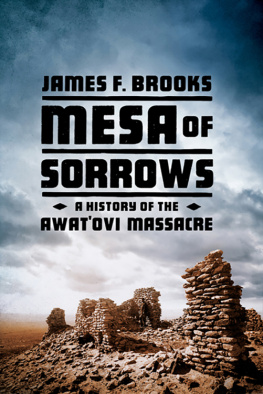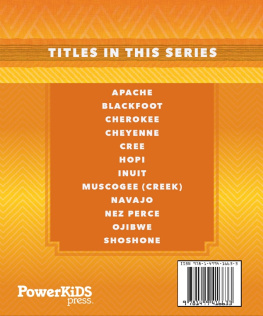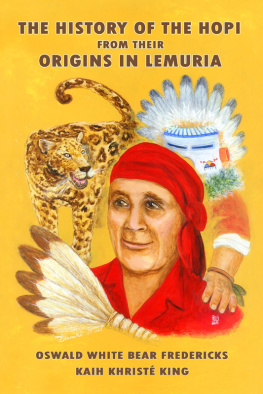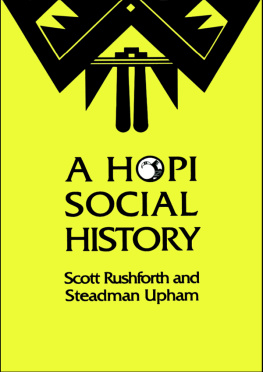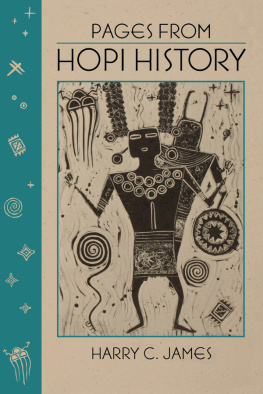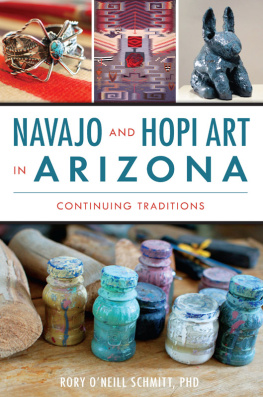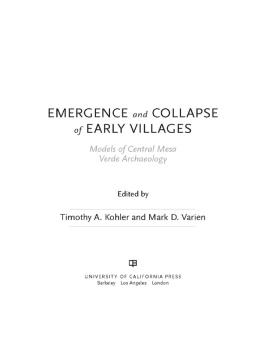T his book found its origins in a conversation with archaeologist Ruth Van Dyke in 2001, when we each held resident scholar appointments at the (then) School of American Research. I was in the final stages of completing Captives and Cousins, a book on intercultural captivity and slavery in the Southwest Borderlands, and Ruth wondered if I knew a variant of that theme in the distribution of the women who survived the massacre at Awatovi Pueblo among the villages of the assailantswere they victims or redeemed from bondage? The following years found me at SAR (which became the School for Advanced Research in 2007) as research faculty, administrator, and executive. Mesa of Sorrows reflects the peculiar alchemy of the many diverse humanists, social scientists, Native scholars and artists that exemplified SARs community. For more than a decades dwelling within that energy and eclecticism, I am grateful. Of special note are resident and visiting colleagues Rebecca A. Allahyari, the late David M. Brugge, Catherine Cameron, Cynthia Chavez Lamar, Catherine Cocks, the late Linda S. Cordell, Sarah Croucher, Armand Fritz, Severin Fowles, George Gumerman, Laura Holt, the late Michael Kabotie (Lomawywesa), John Kantner, Doug Kiel, Stephen H. Lekson, Nancy Owen Lewis, Ramson Lomatewama, the late Hartman Lomawaima, Tsianina Lomawaima, Tiya Miles, Melissa Nelson, Timothy R. Pauketat, Douglas W. Schwartz, Thomas E. Sheridan, David H. Snow, Phillip Tuwaletstiwa, and the late David J. Weber.
St. Johns College president Michael Peters and dean J. Walter Sterling paid me the honor of a visiting scholar invitation in the colleges Liberal Arts Program in 20132014, during which I completed a first draft of the manuscript and heard echoes of windy Ilium in Awatovis story. Alison Colborne at the Laboratory of Anthropology at the Museum of Indian Arts & Cultures in Santa Fe and Patricia Kervick at the Peabody Museum of Archaeology and Ethnology at Harvard University endured my research requests for years. Elizabeth DePalma Digeser and Stuart Smith at the University of California, Santa Barbara, recruited me back to the shores of the Pacific, and each contributed to my thinking about the violence of orthodoxy, heterodoxy, and heresy in cultures ancient and modern, as did friends and colleagues Ryan Abrecht, Liza Black, Debra Blumenthal, Hal Drake, Paige Digeser, Greg Goalwin, Jeff Hoelle, John I. W. Lee, Ann Marie Plane, Adam Sabra, Amber Vanderwarker, Sarah Watkins, and Greg Wilson. Special thanks to Hopi Cultural Preservation officer Leigh J. Kuwanwisiwma, author, musician, interpreter, and guide. All helped me to understand the trauma and promise encompassed in the deep history of the Southwest; none bear responsibility for errors in my interpretations thereof.
Don Lamm kept this book alive against high odds, as did Lynne Withey, who provided enthusiasm when my morale flagged. Its completion may have surprised my agent, Lisa Adams of the Garamond Agency, but she gracefully never let that show. At W. W. Norton, Alexa Pughs voice remained gentle and encouraging no matter what strains I imposed upon her. My editor, John Glusman, gave me the single best writing instruction I have ever received: It is your job to make your reader feel smart, not how smart you are.
Lila and Jeremy helped me to understand the essence of this story: let us try not to make strangers of our kinfolk and neighbors.
ALSO BY JAMES F. BROOKS
Captives and Cousins: Slavery, Kinship, and
Community in the Southwest Borderlands
Confounding the Color Line:
The Indian-Black Experience in North America
Adams, E. Charles. The Origin and Development of the Pueblo Katsina Cult. Tucson: University of Arizona Press, 1991.
Bancroft, Hubert Howe. History of Arizona and New Mexico, 15301888. Vol. 17. San Francisco: The History Co., 1889.
Benavides, Fray Alonso de. Revised Memorial of 1634, with Numerous Supplementary Documents Annotated by F. W. Hodge, G. P. Hammond, and Agapito Rey. Albuquerque: University of New Mexico Press, 1945.
Benedict, Ruth. Patterns of Culture. New York: Mariner Books, 2006 [1934].
Bernardini, Wesley. Hopi Oral Tradition and the Archaeology of Identity. Tucson: University of Arizona Press, 2005.
Billman, Brian R., Patricia M. Lambert, and Banks L. Leonard. Cannibalism, Warfare, and Drought in the Mesa Verde Region During the Twelfth Century A.D. American Antiquity 65, no. 1 (2000): 145178.
Black, Robert, trans. and ed. Standing Flower: The Life of Irving Pabanale, the Arizona Tewa Indian. Salt Lake City: University of Utah Press, 2001.
Boyer, Paul, and Stephen Nissenbaum. Salem Possessed: The Social Origins of Witchcraft. Cambridge: Harvard University Press, 1974.
Brandt, Elizabeth A. Sandia Pueblo. In Alfonso Ortiz, ed., Smithsonian Handbook of North American Indians: The Southwest. Washington, DC: Smithsonian Institution, 1979.
Brew, John Otis. The Excavation of Awatovi. In Marnie Gaede, ed., Camera, Spade, and Pen: Inside View of Southwestern Archaeology. Tucson: University of Arizona Press, 1980.
Brew, John Otis. The First Two Seasons at Awatovi. In American Antiquity 3, no. 2 (1937): 122137.
Brew, John Otis. The History of Awatovi. In Ross Gordon Montgomery, Watson Smith, and John Otis Brew, Franciscan Awatovi. Cambridge: Reports of the Awatovi Expedition Peabody Museum, Harvard University, Report #3, 1949.
Brew, John Otis. Hopi Prehistory and History to 1850. In Alfonso Ortiz, ed., Handbook of North American Indians. Vol. 9, Southwest, 103109. Washington, DC: Smithsonian Institution, 1979.
Brew, John Otis. Preliminary Report of the Peabody Museum Awatovi Expedition of 1939. Plateau 13, no. 3 (1941): 3748.
Brooks, James F. Captives & Cousins: Slavery, Kinship, and Community in the Southwest Borderlands. Chapel Hill: University of North Carolina Press, 2002.
Brooks, James F. Violence and Renewal in the American Southwest. Ethnohistory 49, no. 1 (Spring 2002): 205218.
Brown, Tracy L. Pueblo Indians and Spanish Colonial Authority in Eighteenth-Century New Mexico. Tucson: University of Arizona Press, 2013.
Brugge, David M. The Navajo-Hopi Land Dispute. Albuquerque: University of New Mexico Press, 1999.
Calloway, Colin G. One Vast Winter Count: The Native American West Before Lewis and Clark. Norman: University of Oklahoma Press, 2003.
Chvez, Fray Anglico. Nuestra Seora de la Macana. New Mexico Historical Review 34 (1959): 81100.
Clements, William M. A Continual Beginning, and Then an Ending, and Then a Beginning Again: Hopi Apocalypticism in the New Age. Journal of the Southwest 46, no. 4 (2004): 643660.
Clemmer, Richard O. Then Will You Rise and Strike My Head from My Neck: Hopi Prophecy and the Discourse of Empowerment. American Indian Quarterly 19, no. 1 (1995): 3173.
Colton, Harold, and Edmund Nequatewa. The Ladder Dance: Two Traditions of an Extinct Hopi Ceremonial. Museum of Northern Arizona Notes 5, no. 2 (1932): 512.
Cordell, Linda S., and Maxine E. McBrinn. Archaeology of the Southwest, 3rd ed. Walnut Creek, CA: Left Coast Press, 2012.
Courlander, Harold. The Fourth World of the Hopis: The Epic Story of the Hopi Indians as Preserved in their Legends and Traditions. New York: Crown Publishers, 1971.
Courlander, Harold. Hopi Voices: Recollections, Traditions, and Narratives of the Hopi Indians. Albuquerque: University of New Mexico Press, 1982.
Cushing, Frank Hamilton. Killing Sorcerers: Remarkable Customs of the Zuni Indians in New Mexico. Reprinted in Jesse Green, ed., Cushing at Zuni: The Correspondence and Journals of Frank Hamilton Cushing, 18791884. Albuquerque: University of New Mexico Press, 1990.
Next page
